By Marc Cammack
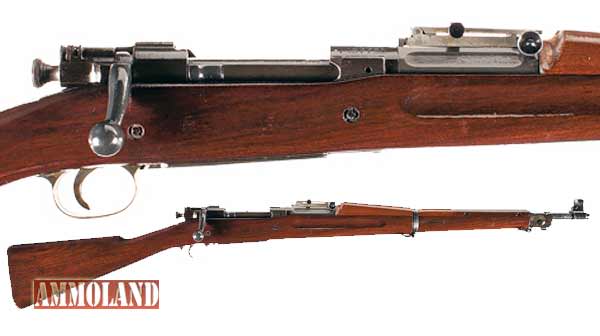
Bangor, Maine -(Ammoland.com)- One of the most collected military firearms today is the 1903 Springfield rifle in 30-06.
The 1903 rifle’s story began in the late 19th Century. It had a long service life, because it was the standard issue rifle for the US Army from 1903 until the adoption of the M1 Garand in 1936.
Despite its replacement this rifle continued to serve into World War Two. The 1903 Springfield rifle came in several different variants for a variety of different tasks. In this first article we will examine the 1903’s early history and its history in World War One.
1903 Springfield Rifle
American troops entered the Spanish American War lacking many modern weapons. Many Army units were equipped with outdated single shot Trapdoors while others were equipped with the more modern Krag rifle. Spanish troops were often armed with newer 1893 Mauser rifles in 7mm. The Mauser was much quicker to load due to its ability to use 5 round stripper clips, and the 7mm round shot farther than the Krag’s .30-40 round. These flaws lead the U.S. Ordnance Department to seek a better weapon.

Smokeless powder rifles became available in the late 19th century starting a worldwide arms race, resulting in the US Army adopting the Krag rifle in 1892. Five Mausers were tested against the Krag including an 1889 Belgian Model, but none of them were adopted. The Krag’s reliability with rimmed cartridges was one of the reasons it was chosen as a service rifle. Two other features of the Krag that led to its adoption were its ability to be used as a single shot weapon and the ability to quickly top off the magazine.
Springfield Armory came up with new rifle prototypes starting with the Model 1900 rifle. These prototypes lead to the 1903 Springfield rifle in .30-03. The 1903 embodied features from the Mauser like the magazine and its ability to use stripper clips. These features later caused legal issues between Springfield Armory and Paul Mauser. It also had a magazine cutoff with the intention of preventing wasteful use of ammunition. The 1903 Springfield rifle was produced both at Springfield Armory in Massachusetts and Rock Island Arsenal in Illinois.
Early 1903 rifles had a rod bayonet underneath the barrel.
Teddy Roosevelt was not fond of this type of bayonet. In a 1905 letter to the Secretary of War the then President Roosevelt stated that “I must say that I think the ramrod bayonet about as poor an invention as I ever saw”.
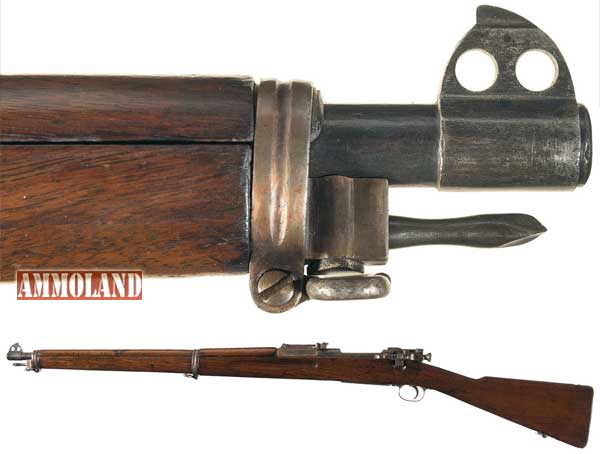
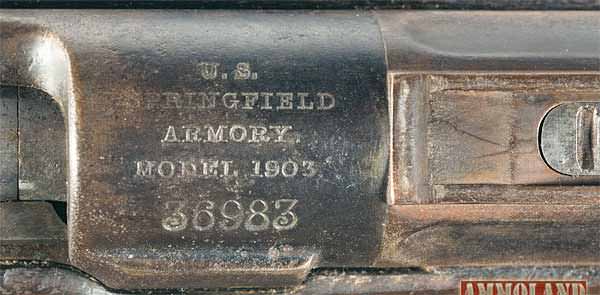
This influence led to the adoption of a 16 inch blade type bayonet called the M1905, that also fit on the later on M1 Garand rifle. As a result of this decision authentic rod bayonet 1903 rifles today are very rare due to the vast majority of the rifles being converted to take blade type bayonets. Also changed was the rear sight and the ammunition. It was chambered in a different round called the .30 1906 or .30-06, which had a 150 grain bullet instead of the .30-03’s 220 grain bullet.
Teddy Roosevelt ordered a personal sporter version of the 1903 Springfield rifle directly from Springfield Armory. Roosevelt’s sporter was chambered in .30-03 as it was made in 1904, and its serial number was 6000. He took this rifle to Africa and other hunts within the United States. Teddy’s son Kermit purchased a .30-03 sporter of the 1903 Springfield Rifle for himself as well and this rifle was serial number 85806. .30-03 was chosen over the .30-06 for commonality of caliber between Teddy and Kermit’s 1903 Springfield Rifles.
1903 Springfield Rifle Goes To War
It would not be long before the 1903 Springfield rifle was in combat. It was used in many of the conflicts that the United States was involved with in Latin America often called the “Banana Wars”. It was used by the Marine Corps during their 1914 occupation of Veracruz. Pershing’s troops also carried the weapon during their chase of Pancho Villa in 1916-1917.
World War One proved to the ultimate test for the 1903 Springfield rifle. Marines used the weapon to great effect at the Battle of Belleau Wood in June, 1918, when they shot German troops at long ranges. However there were not enough 1903 rifles on hand to equip all American troops fighting in France. Remington, Winchester, and Eddystone produced the 1917 Enfield in .30-06 (read my related article America’s Enfield M1917 Rifle in .30-06) in order to equip American troops. A majority of American troops fighting in World War One were equipped with the 1917 Enfield. Despite this 1903 Springfield Rifle still saw widespread use by both Army and Marine divisions throughout some of the famous battles of the war like the Meuse Argonne Offensive.
One major issue that arose during World War One was heat treatment of the 1903’s receivers. A very small number of receivers failed due in part to errors in the heat treatment process and also due to issues with cartridge case hardness. To correct this problem both factories began double heat treating their receivers. This process began in February, 1918 at Springfield Armory with serial number 800,000 and in May, 1918 at Rock Island Arsenal with serial number 285,507. Thus any serial number after the above is considered safe to shoot, but it is always a wise idea to have any used firearm checked out by a competent gunsmith for safety reasons.
There were attempts to convert the 1903 Springfield Rifle to full power semi automatic rifle, one of which was designed by Grant Hammond. (Hammond also designed a .45 pistol was tested by the Army in 1917 and 1918) Both Springfield Armory and Rock Island made unsuccessful semi automatic conversions of the 1903. There was also an attempt to convert the rifle to a pump action repeater by a Greek immigrant named Demetrios Stergian-opulous.
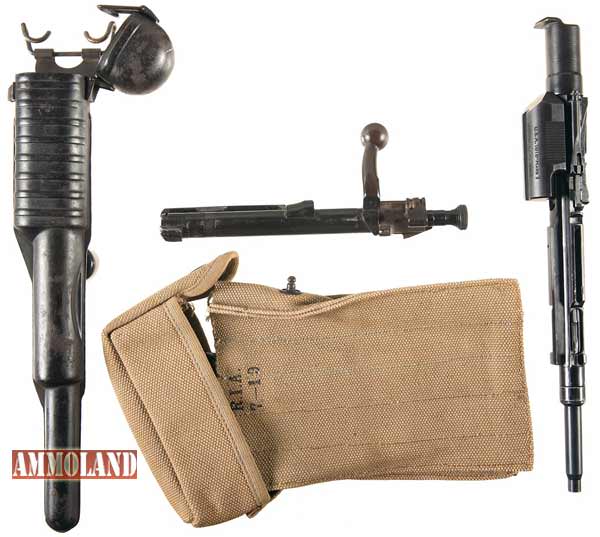
John Pedersen designer of the Remington Model 51 pistol, approached the Ordnance Department in 1917 with a novel idea. This was to convert a 1903 rifle to fire a .32 caliber pistol round and for the rifle to use a magazine that held 40 rounds. This conversion kit was known as the Pedersen Device and it could convert a 1903 rifle to a semi automatic pistol caliber rifle in mere seconds by replacing the bolt assembly and inserting the new magazine. The kit weighed 2 pounds 2 ounces unloaded and could be easily carried on a soldier’s belt.
A specific model of the 1903 Springfield rifle was made for the Pedersen Device called the Mark 1. Mark 1 rifles had a cutout on the left side of the receiver for the ejection of spent .32 cartridges. Many of the Mark 1 rifles were made between 1918 and 1921, despite the short life of the Pedersen Device. It was intended to help bring about an end to World War One. American troops were supposed to use them while fighting in the close quarters of the trenches. 500,000 Pedersen Devices were projected to be made for the planned 1919 Offensives. 65,000 Pedersen Devices had been made before World War One ended on November 11, 1918 , and as a result the Pedersen Device was never used in combat. After the war most were destroyed making the few surviving examples today very valuable.
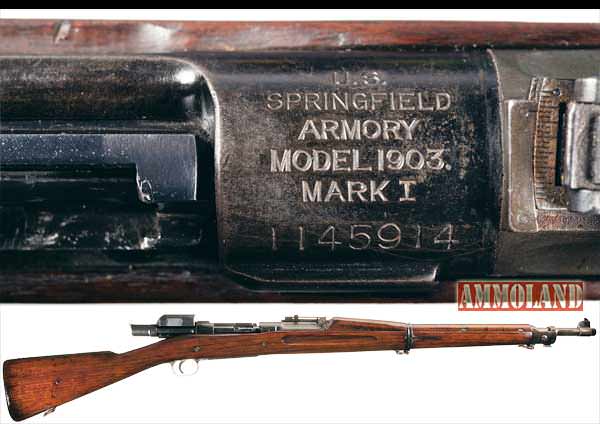
The 1903 Springfield rifle’s history did not end with the cessation of hostiles in 1918 and it had much more service life left.
In the next article we will look at the 1903’s history in the interwar period and during World War Two. Also we will look at National Match, civilian, and sniper variations. Finally we will look at the 1903A3, which was an easier to make version of the 1903 Springfield Rifle that was made by Remington and Smith Corona.
* Images: Rock Island Auction Company ( www.rockislandauction.com )
1903 Springfield Rifle Resources:
- The Springfield 1903 Rifles – The Book : https://goo.gl/oY3TIz
- Springfield 1903 Rifle Parts & Ammo : https://goo.gl/M7vn0T
- More Springfield Info & History at NRA Firearms Museum
About Marc Cammack
Marc Cammack has been collecting firearms since he was 14 years old.
His interests are primarily military surplus firearms of the late 19th into the 1950’s. He has studied these in depth, and currently volunteers at two local museums providing them with accurate information about their firearms.
He is a graduate of the University of Maine with a bachelor’s degree in history. He has studied modern European and American history since the age of 9, and has been shooting since the age of 11. He currently resides just outside of Bangor, Maine.


I have held on to my 1903-A3, Smith Corona, dated 43-09, Star barrel, clean in the box, oiled. No cosmoline, from NRA, 1963, $14.10, #3745XX, many, many thousand ball rounds, hunting, cast gas checked, 50 years +, barrel is still bright on the sharp lands, dark in the groves .
Grandsons in the wings?!?.waiting!
¿Question?, Does the star really mean a match barrel or ??
Steve, Big Bend Ca.
HI I have a US Springfield armory Model 1903 / ser# 13503++ /CAL.270 age 70yrs or older I was told it was not made in this cal. can you help me _ my father got it in the 40ties + he put a manlickler stock on it custom made by him. thank you I live in Lewiston me anything you can add will help thks-dan.
never left service until well into the 1970’s…….. and although officially replaced by the M1 entire u.s battalions were still armed with them by the end of WWII. fantasic mauser action variant.
Was the Springfield rifle used as a sniper rifle in ww2?
Yes it was, in two models. The 1903A4, issued to Army Scout Snipers, and the USMC 1903A1. Made by Marine armorers for Marine Scout Snipers.
In either 1961 or ’62, I bought a 1903 Springfield from the NRA for 15.00 dollars believe it or not!, I sporterized it and gave it to my dad for a deer hunting rifle….he really liked that rifle!